
Genealogie Härting
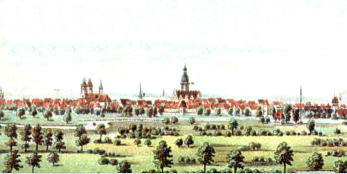
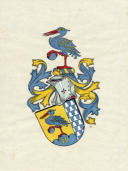
Härting
Onomastics
A
very
interesting
area
within
the
scope
of
the
family
historical
research
is
the
onomastics
.
With
its
help
it
is
possible
to
draw
conclusions
about
the
spreading
area
1
of
a
family
name
and
therefore
about
the
origin
of
a
name
holder,
even
further
than
the
current general family historical sources.
Family
names
(FN)
got
slowly
popular
since
the
12
th
century
in
Germany.
Till
then,
only
first
names
or
rather
full
names
were
common
like
Hardus,
Harto
and
so
forth
which
were
sufficient
enough
as
distinctive
feature
at
the
times
by
low
population
density.
FN
were
mostly
formed
by
personal
names,
animal
names,
plant
names,
house
names,
yard
names,
meadow
names,
place
names
and
names
of
occupations.
The
furthest
back
in
the
past
ara
places
with
the
suffix-ing
which
were
generated by personal names (
patronymic
).
An
important
role
in
generating
FN
had
the
medieval
German
east
settlement
in
the
8
th
to
the
14
th
century
as
the
development
of
the
cities
which
were
connected
through
internal
migration.
Therefore,
name
forming
was
promoted
especially
by
occupations
and
point
of
origin
e.g.
Pertholt
de
Hartingen
(Berthold
von
Harting).
Ha(ae)rting
is
a
small
places
in
Bavaria,
three kilometres southeastern of Regensburg.
1
Association for Computergenealogie e. V., Dortmund.
2
Censualen (Zensualen) are not free people in serfdom who were liable to interest. After the Censualen law the people had an interest (To pay deliveries,
rent) to the lord of the manor.
3
CF. O. Dobenecker, 4th tape (1267 - 1288) and P. Bohemian, document book of the cloister gate (1351 - 1500).
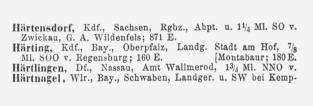
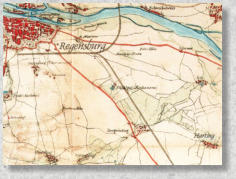
Unfortunately,
was
defeated
of
the
centuries
surname
by
a
constant
name
change.
This
it
was
changed
of
the
surname,
among
the
rest,
in
Germany
also
often
with
the
possession
or
the
dwelling
house.
Only
since
the
17th
century
the
name
change
was
prevented
and
established
the
surname
bit
by
bit.
There
was
another
problem
by
the
name
change
by
the
different
manner
of
writing
which
was
allowed,
unfortunately,
to
far
back
in
the
19th
century.
The
registration
of
the
surname
in
documents
and
registers
almost
never
occurred
after
examination
of
documentary
documents,
but
according
to
verbal
information,
as
well
as
it
the
writer
understood.
In
a
hereditary
bill
of
sale
more
than
three
acres
of
field
from
the
11th
of
March,
1659
it
seems
of
the
surname
Härting
in
three
variations.
In
the
text
of
the
local
court
clerk
of
Pegau
the
buyer
is
written
once
as
a
Glorius
Härting
and
at
other
place
than
Glorio
Härtingen,
while
he
himself
signs
with
own
hand
as
a
Glorius
Herttingk.
Now
with
the
help
of
the
name
research
I
have
tried
to
investigate,
after
the
general
family-historical
springs,
the
historical
development of the surname Härting and therefore the supposed origin of my forefathers..
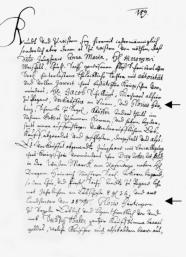
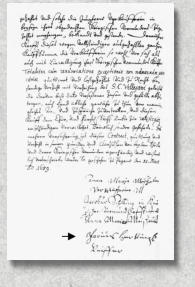
The place Harting 3 km southeast
from Regensburg remotely
(Map cutting of 1858)
Cutting from the local encyclopaedia
from Germany in 1868 with him
Local names Härting.
From
Hard/hard,
got.
Hardus
educated
family
names
we
find
again
in
the
West-Frankish
space
already
in
the
6th
century
under
the
frequent
name
Leodardus,
Medardus,
Gothardus
etc.
till
the
12th
century.
The
Gothic
family
name
Hardus
should
be
provable
even
already
in
the
3th
century
as
an
own
name.
From
the
Old
High
German
full
names
Ardo/Harto
formed
bit
by
bit
New High German surname as for example:
.
> Hartes-Harden-Herdh(e)-Heerdt-Hört(h)
with the patronymischen derivations:
> Hart(d)ung-Harti(n)g-Herding-Herti(n)g-Härtig
and the dialectal distortions:
> Harding-Hartingk-Hert(t)ingk-Haerting-Härdtingk-
Härttingk-
Härting
.
from
the
Germanic
space
of
Bojohaemum
(Bohemia)
in
Raetia
(Bavaria).
By
newer
knowledge
in
the
archaeological
research
these
were
the
markomannische
southwest
Bohemians
who
settled
above
all
in
the
river
rooms
to
the
north
of
the
Danube
around
Regensburg,
so
also
in
the
area
of
the
today's
place
Harting.
In
the
middle
of
the
6th
century
wasted
the
concept
Raetien
which
was
a
Roman
province
since
the
1st
century
and
by
Baiuvari,
men
from
the
country
of
Baia
(Bohemia)
was
substituted.
With
us
in
Germany
the
clan
names
ending
on
ingineer
seem
especially
remarkably
in
Swabia
and
Bavaria.
Here
the
suffix
ing
appears
in
formal-ing-heap
and
even
more
ing-lines
arranged,
thus
on
the
edge
of
the
big
river
valleys,
generally
with
predilection in the level and fertile country..
Some-ing-places,-ing-lines and-ing-heap in the Munich surroundings
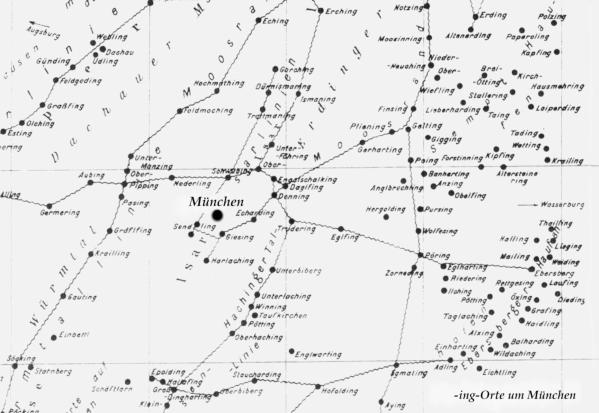
The
place
Harting
near
Regensburg
was
mentioned
in
a
document
already
863/864
be
as
the
noble
Arnedo
Own
to
Hartinga
(settlement near Regensburg) against a fief to Tann (settlement near Regensburg) sold.
Under
Heinrich
1st
who
combined
Saxony,
Thuringia,
Franconia,
Swabia,
Bavaria
and
925
Lorraine
as
a
king
919
five
family
dukedoms
,
the
recovery
of
the
German
east
which
was
settled
up
to
beginning
of
the
migration
in
375
AD
already
by
Germanic
trunks
such
as
Langobards,
Semonen,
Sueben
(Swabians),
Markomannen
(Bavarians),
Vandals
etc.
was
initiated.
Heinrich
1st
also
guarded
the
country
in
the
east
against
the
inspirations
of
the
west
Slavs
(Sorben
and
Wenden)
and
Magyaren
(Hungary)
and
established
not
only
border
brands,
but
fastened
his
borders
through
imperial
castles
as
for
example
Groitzsch
(
castle
Wiprechts)
,
Leipzig
(castle
Pleissen)
,
Altenburg
etc.
in
whose
protective
area
new
towns
were
founded.
Under him also originated in the area settled by Slavs the brands Zeitz, Merseburg and Meissen, later Saxony.
Now
the
Frankish-German,
rural
settlement
beginning
bit
by
bit
already
already
in
the
8th
century
of
the
east
was
carried
out
under
duke
Lothar
von
Sachsen,
count
Wiprecht
II.
of
Groitzsch
,
duke
Heinrich
to
the
lion
of
Saxony
and
by
the
mission
work
of the cloisters increasingly.
In
the
anal
Pegavienses
to
1104
it
is
reported
that
count
Wiprecht
II
of
Groitzsch
took
the
vast
woodlands
between
the
rivers
Schnauder,
Wyhra
and
Mulde
with
Frankish
colonists,
which
he
himself
in
big
number
from
the
area
around
Regensburg
to
fetch.
Also
the
cloister
Saint
Emmeram
in
Regensburg
was
already
at
the
end
of
the
8th
century
a
centre
for
mission
work
in
the Slav's area between Saale and Elster.
Possibly
at
this
time
we
find
in
the
documents
of
the
bishopric
Regensburg
and
the
cloister
Saint
Emmeram
the
proof
of
some
Ha(e)rting-name bearers who were resident in the Bavarian place Harting/Härting near Regensburg about 125 years:
Family history research in Saxony
Obviously
it
concerns
people
of
a
clan
who
were
resident
at
this
time
in
the
settlement/colony
Harting
and
which
more
together
former
forefather
than
the
first
owner
and
founder
could
also
have
given
the
local
name
Harting
in
the
8th
century,
this
old
bajuwarischen
settlement.
The
name
of
the
colony
Harting,
borrowed
by
the
first
owner,
stuck
in
the
properties
and
then
went
over
on
his
successor.
On
the
other
hand,
it
could
act
with
the
call
names
performed
on
top
Berthold,
Otto,
Bruno,
Heinrich
and
Hermann
Ulli,
also
around
the
later
incurred
people
who
have
received
the
place
of
origin
Harting
as
a
remarkable
sign
in
the
documents
to
the
differentiation
as
epithets.
Because
more
and
more
people
carried
the
same
first
name, an unequivocal identification single was not guaranteed any more.
After
the
fall
Heinrich
of
the
lion
in
the
year
1180
suddenly
broke
down
the
mighty
Saxon
dukedom
which
to
himself
now
on
the
possessions
of
the
count
Bernhard
von
Askanien,
a
son
of
the
Saxon's
duke
Albrecht
of
the
bear,
limited.
He
combined
his
hereditary
country
on
the
upper
Elbe
around
Wittenberg
with
Lauenburg
under
the
name
of
a
dukedom
Saxony.
After
the
extinction
of
the
gender
of
the
Askanier
in
the
year
1422,
mark
count
Friedrich
1th
the
Warlike
received
the
country
and
the
health
resort
dignity
from
Meissen
as
royal
fiefdom.
The
land
name
"Saxony"
walked
with
it
Elbe
upstream
and
became
gradual
also
for
the
brands
Merseburg,
Zeitz
and
Meissen
common.
The
political
concept
Saxony
has
been
shifted
in
the
family
country
of
the
old
Saxons
by
North
West
Germany
to
Central
Germany,
while
the
old
Saxons
remained
as
people
in
North Germany, today Lower Saxony.
From
the
knowledge
of
the
onomastics
and
the
historical
development
of
Medium
German
Saxony
we
can
suppose
that
the
Härtingschen
forefathers
had
moved
during
the
big
German
east
settlement,
possibly
in
the
beginnings
of
the
13th/14th
century
as
Swabian-Bavarian
colonial
farmers,
presumably
from
the
place
H(ä)rting,
to
Sorben
in
the
brands
Zeitz
and
Merseburg, to today's Saxony.
Some
documents
from
the
13th/14th
century
point
to
the
fact
that
our
forefathers
could
possibly
have
moved
from
north
Bavarians
via
Thuringia
in
the
brands
Zeitz
and
Merseburg.
Since
on
the
23rd
of
July,
1280
Hartung
von
Sachsenhausen
kicked
first
with
a
purchase
of
land
near
Weimar
in
Thuringia
as
a
witness
on.
Further
Hans
Hertnick
(probably
Hertinck)
to
Buttelstedt
sold
on
the
4th
of
February,
1425
by
Weimar
all
his
goods
in
Sachsenhausen,
Leutenthal
and
Obringen
for
200
Rhenish
guilders
in
Ludolf
of
Arnstdt
in
Zoppothen
by
Saalburg.
These
Hertinckschen
goods
became,
finally,
on
the
9th
of
March,
in
the
year
1427
by
Friedrich
1th
landgrave
in
Thuringia,
mark
count
Meissen
and
count
palatine
to
Saxony
to
the
cloister
Pforte
near
Naumburg,
hand
over
to
3
the
family
Hans
Hertinck
has
possibly
moved
to
the
sales
of
his
goods
from
Thuringia
to
Saxony
in
the
direction
of
Naumburg,
Zeitz
and
Pegau
.
Also
in
Naumburg
and
Zeitz
have
sat
down
Ha(e)rting-
name bearer according to the Turks and land tax registers possibly at the middle of the 16th century, as for example:
> Mattes Hartting, in 1551 in Naumburg, Langemergengasse, with a property value of 135 n.ßo, pays 5 fl. 16 gr. 10 Pf.
Country tax and 1 fl. 9 gr. 5 Pf. Turks tax.
> Bartel Herting, in 1568 in Zeitz, in the Vorstetten before the Wasserthor, with a property value of 5 n.ßo, pays 3 gr. 9 d.
Country tax for house and court.
.
On
the
31.10.1095
Perhtolt
de
Hartingen
with
his
father
Otto
appear
together
with
other
16
people
than
witnesses
in
Regensburg
when
abbot
Pabo
with
the
servant
exchanges
Machthild
of
the
cloister
Saint
Emmeram,
possessions
to
Isling
(settlement
near
Regensburg).
Further
appear
in
the
year
1105
Perhtoldus
de
Hartingen
together
with
other
six
people
than
witnesses in Regensburg than Enziman hands over a serf as a Censualen
2
.
> Bruno of Herting and Heinrich of Herting (1135 -1160).
In
1155
Bruno
and
father
Henricu
de
Hertingen
appear
together
with
other
16
people
than
witnesses
in
Regensburg
when
of
the
Diocese-ministerial
Haward
of
the
abbot
Adalbert
in
exchange
for
possession
to
Harting
a
farm
receives
to
Gämelkofen
(settlement
near
Regensburg),
further
than
fiefs
a
farm
to
Helmprechting
(settlement
near
Regensburg)
and
a
vineyard near Schwabelweis (settlement near Regensburg) .
> Hermann Ulli of Herting (1219).
In
1219
Hermannus
uillicus
de
Hertinge
appears
together
with
other
14
people
than
witnesses
than
Irnfrid
of
Dünzling
(settlement near Regensburg) hands over his woman and his children as a Censualen.
.
With
the
family
names
ending
on
ingineer
it
concerns
certainly
the
oldest
German
clan
names
which
are
due
to
the
oldest
German
settlements
of
the
Bavarians
(Markomannen),
who
sat
down during the migration over the Danube pushing forward



The hereditary bill of sale from the 11th of March,
1659 in which the same name was found in three
different manners of writing such as
Glorius Härting, Glorio Härtingen, Glorius Herttingk
>
Berthold of Harting
and
Otto of Harting
(1095 - 1120).



Pegau around 1625
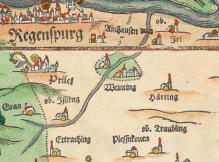
The place Härting near Regensburg
(Bavaria map from Philip Apian 1568)













